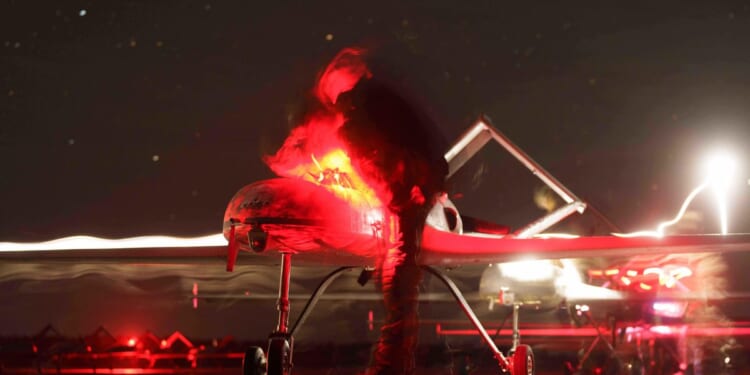
SEOUL, South Korea — Ukrainian forces have made global headlines since 2022 by turning commercial products such as off-the-shelf consumer drones into weaponry and battlefield equipment to gain an edge over the conventional military hardware of Russian invaders.
But that edge is at risk of crumbling, according to a Ukrainian-American former tech executive, who’s gained international recognition for directly supplying front-line Ukrainian units with dual-use technologies sourced from civilian markets around the world.
Andrey Liscovich, president of the Ukraine Defense Fund, told The Washington Times during a recent trip to South Korea — one of 30 nations he’s visited this year — that the dual-use technologies Kyiv has deployed so effectively in war are at risk of maxing out amid Russia’s own innovative advances.
“My ability to impact the war is diminishing over time,” said Mr. Liscovich, who has spent the past three years leveraging his Silicon Valley expertise and contacts to broker deals that have delivered high-tech equipment and munitions to Kyiv’s forces.
“I have doubts that dual-use has a lot of room left to run; we are reaching a frontier,” he said. As the wartime “cat and mouse” game of measures and countermeasures accelerates, “we are starting to see diminishing returns,” he said. “We need to do basic science and apply it to defense.”
It’s a sobering assessment that may surprise observers in a war where most conventional artillery — a core strength of the Russian military — has been shoved out of range by the expanded kill zone of innovative Ukrainian drones.
But Russia is responding with its own “reinvention of military-grade equipment,” said Mr. Liscovich, who referenced dedicated miltary tech — hardened, jamming-proofed — being developed and deployed by Moscow in response to Ukraine’s battlefield innovations.
“Success will come to the side which pushes the frontiers of basic science,” he said.
Mr. Liscovich would know. After earning a doctorate from Harvard in 2015, he worked for years in the U.S. tech sector, including as the CEO of Uber Works. When Russia invaded Ukraine in 2022, he pivoted and co-founded the nonprofit Ukraine Defense Fund, channeling his tech and supply chain experience into procuring and delivering items directly to Ukrainian forces, away from the bureaucracy of conventional nation-to-nation military aid.
The approach aided Ukraine’s innovation edge against Russian invaders.
In similar fashion to the way Silicon Valley firms make improvements on evolving technologies based on feedback from consumers, Ukrainian forces have outpaced the Russians in fusing different consumer technologies, then adapting and evolving those technologies based on battlefield needs.
Prior to invading Ukraine, the Russian military industrial complex was not adept at benefiting from the feedback loop concept that’s baked into Silicon Valley’s business model, said Mr. Liscovich, who studied science in Russia prior to his time at Harvard and career in California’s tech sector.
But the war’s harsh lessons have changed that, with Russian engineers now communicating with front-line end-users. Moreover, war is imitative. “They took what Ukraine showed worked, and up-scaled and standardized,” Mr. Liscovich said.
While manpower losses on both sides remain secret, open-source intelligence channels verify heavy equipment losses by cross-referencing battlefield images and satellite data. Current numbers paint a grim picture.
“We are now at our worst-ever loss ratios,” Mr. Liscovich said.
Given Russia’s superiority in troops, equipment and firepower, “our early idea was to fight asymmetrically,” he said.
Drones were a no-brainer: In global tech markets, “there are no binding constraints on their components … they were a low-hanging fruit that had built up in peacetime.”
Chinese drones — some designed for wedding photography — proved numerous, cheap and easily weaponizable.
Mortar bombs or grenades could be added and flown directly into targets as kamikaze drones, or dropped from a hovering drone into targets as small as foxholes and vehicle hatches.
Mr. Liscovich said Ukrainian engineers “jail broke” the locator software of such drones, and added improved batteries and antennae.
Other civilian technologies included power banks, batteries, tablets and communications systems.
And Starlink, the convenient, internet-providing satellite constellation owned by Elon Musk’s SpaceX, was a game-changer following Russia’s initial attack on Ukraine.
However, Kyiv was not offered the “Starshield” military-grade version of the technology. And, according to Mr. Liscovich, Russia is now capable of jamming Starlink and locating the ground-based satellite terminals it relies upon.
Russians are also using Starlink, having acquired it from countries in the Middle East, he said, adding that ongoing developments in Ukraine point to the importance of dedicated military technology.
“We need to learn to frequency-hop,” he said, “to do the kind of things civilian vendors never had to do.”
He added that the war has rapidly progressed through phases.
Early industrial competition was in artillery, the key killing arm.
Russia, aided by North Korea, won the munitions production race. “The West failed,” Mr. Liscovich said.
To compensate for the imbalance in firepower and the burnout rate of gun barrels, Ukraine turned to strike drones, which proved effective against armor in the open as well as artillery, as howitzers and tactical rocket systems are large, easy to identify and hard to hide.
As a result, the big guns moved back, impacting accuracy: “Precision decreases with distance,” said Mr. Liscovich.
With drone swarms dropped by relays of “mother drones,” he explained, the kill zone is currently 25 miles deep.
While specialized long-range munitions exist, the range of Russia’s basic 152mm howitzer does not exceed 15 miles.
Unjammable fiberoptic drones are also proving flexible against makeshift defenses such as netting strung over supply routes.
Such drones can land beside a road and “hibernate” in low-power mode, Mr. Liscovich said, adding that when a target approaches, the drone powers up and zooms under the lower edge of the hanging netting to strike.
“The front is now quieter … there is nothing big,” said Mr. Liscovich, who reflected that the crump of artillery barrages has been replaced by “the buzz of drones.”
Russia is responding by expanding glide bomb use. These massive munitions are released by aircraft at distance and guided down to detonation.
Behind the front, both sides are hitting strategic targets, such as power-generation facilities and arms plants.
“Russia’s targeting is getting better,” Mr. Liscovich said.
Ukraine’s Soviet-era factories were easily hit, he said, but newer companies, nondescript or even underground, are also being struck.
Mr. Liscovich cited Russia’s expanded satellite constellation and human intelligence: “Ukrainians can’t keep their mouths shut,” he fretted.
Mr. Liscovich’s contentions on Russia’s improving war tech is reflected on the other side of the front.
The Russia-based YouTube Channel “Real Reporter” last month interviewed “Maxim,” a Russian assault team commander who fought in Ukraine and currently operates a private institute that trains Russian volunteers for combat.
“Our army had forgotten how to fight,” Maxim says in the video, claiming that Russia is now “teaching its army how to fight all over again.”
“You need to get training centers running, build the infrastructure… revive design bureaus, develop new weapons,” he said. “That takes time.”
Mr. Liscovich fears time is not on Ukraine’s side as attrition bites.
“It’s about accounting,” he said. “Who can bring more high-lethality resources to the fight?”










